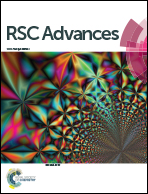Active porous valves for plug actuation and plug flow manipulation in open channel fluidics†
Abstract
We present an alternative tool for plug actuation and valving in open-channel fluidics. Initially the porous and hydrophobic fluidic walls are sticky and the plug is pinned; the valve is “off”. By applying pressure at the rear face (backpressure), the walls become slippery, the plug is depinned and moves along the fluidic; the valve is “on”. The switching is reversible, in that if the backpressure is set off, the plug pins back again, and the valve is turned “off”. We demonstrate the basic principles of the tool, and we provide experimental results on the minimum backpressure to leverage the actuation and the valve switching for fluidics of various cross-sections. Large cross-section fluidics may facilitate the control of a wide range of liquid volumes, at different operating parameters. For valves with small cross sections, the adequate backpressure is ultra-low (less than 10 mbar) corresponding to respectively ultra-low operation energy demands. In advance, for the small cross-section fluidics the backpressure is independent of the droplet volume and tilt angle, thus providing an attractive, versatile actuation and valving tool for low cost open channel fluidics.



 Please wait while we load your content...
Please wait while we load your content...